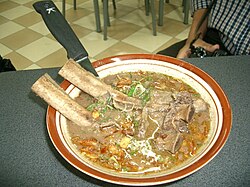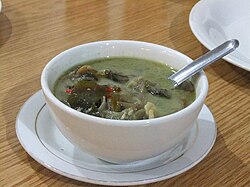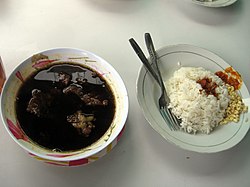
This is a list of Indonesian soups. Indonesian cuisine is diverse, in part because Indonesia is composed of approximately 6,000 populated islands of the total 18,000 in the world's largest archipelago, [1] with more than 600 ethnic groups. [2] Many regional cuisines exist, often based upon indigenous culture and foreign influences. [1] Indonesian soups are known to be flavoursome with generous amount of bumbu spice mixture.
Contents
- Variety
- Indonesian soups and stews
- Soto (traditional soups)
- Sayur (vegetable soups)
- Chicken soups
- Fish or seafood soups
- Meat and offal soups
- Noodle soups
- Gallery
- Commercially prepared soups
- See also
- References
- External links
Indonesian cuisine has a diverse variety of soups. [3] Some Indonesian soups may be served as meals, [3] while others are lighter. [4] The Makassarese of South Sulawesi, Indonesia are known for preparing "hearty beef soups" [5] that also use coconut and lemongrass as ingredients. [6]































